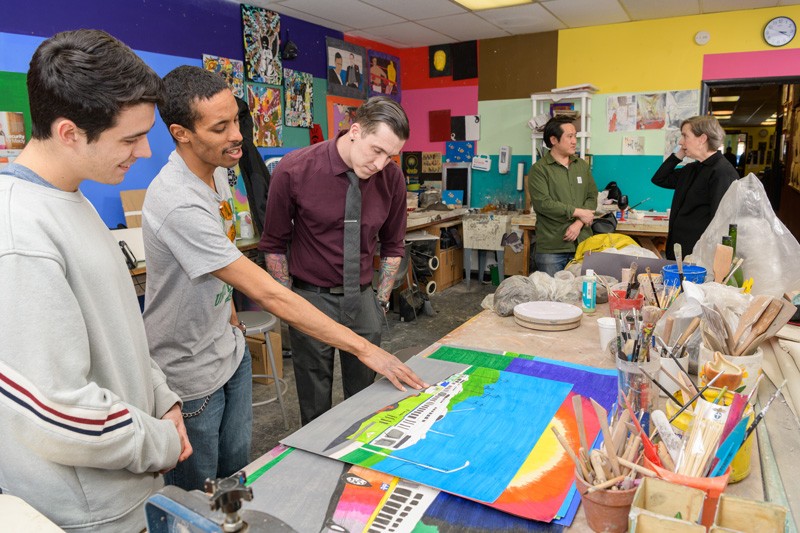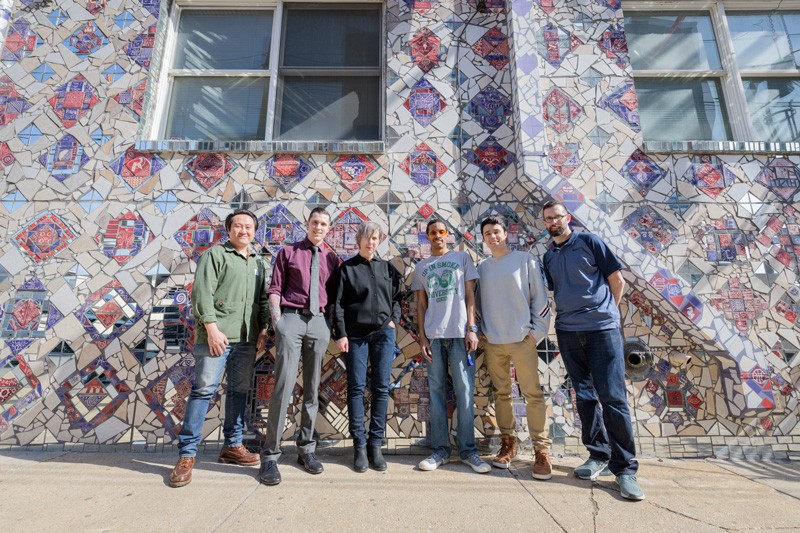creative vision factory : Creating community
UD students develop online gallery for Wilmington artists

Many artists who use studio space at the nonprofit Creative Vision Factory (CVF) in Wilmington find both a creative outlet and a sense of community there, a way to help them deal with the struggles theyve faced in life.
Now, a project undertaken in partnership with the University of Delaware will ensure that sharing their art will no longer be one of those struggles.
Students and faculty have developed a digital archive where the public can learn about some of the artists and view a selection of their work. Plans are to continue expanding the archive with additional artists and new works.
CVF was founded by UD alumnus Michael Kalmbach to provide a community and support for artists on the behavioral health spectrum. Its members have produced impressive work over the years, but the organizations resources including tight space in its storefront building have limited the artists ability to show their work.
The archive is a really important project that weve just never been able to find time for, so we were very grateful for the Universitys help, said Kalmbach, who earned his master of fine arts degree from UD in 2008.
Preserving the artists work is critically important, and because the archive is digital, it not only saves space but we can continue to add to it.
The initiative was part of a one-year series of University courses called the Wilmington Archives Project, which included such topics as storytelling, digital humanities and environmental justice, all using Delawares largest city as a focus and all involving community partners.
When Anne Bowler, associate professor of sociology, was approached about taking part in the project, she was already familiar with CVF and immediately thought that students in her Sociology of Art and Culture class could learn a lot by working there.

I knew my students could benefit from a collaboration, but I wanted to make sure that the Creative Vision Factory would benefit, too, she said. I asked what they needed, and they immediately asked for our help in creating an archive that would organize the artists work and make it accessible.
Students in the class were paired with CVF members and, throughout fall semester, worked on developing biographies of the artists and learning about the works they created. In their final presentations in December, a crowd gathered at CVF to hear each student showcase a particular artist.
David Kim, assistant professor of English and, with Kalmbach, a principal investigator with the Wilmington Archives Project, then developed the website for the content provided by the students and artists.
I wanted to continue the kind of work I had done in New York and Los Angeles to help preserve cultural heritage, Kim said. I saw shoe-string operations there that didnt have the means to archive, document and share their work with the public. Universities need to work collaboratively with community groups, to share our work and co-create.
The UD students described their experience as an opportunity to move beyond the classroom and to try something that was both hands-on and community-based. All said they were impressed by the quality of work the CVF artists created and by their personal stories.
It was great to work with artists, even just as the middleman, said Dillon DiGuglielmo, a senior majoring in criminal justice. And the community aspect was a real eye-opener. I did an [earlier] internship just up the street, working with Family Court, but this gave me a new perspective of the community.
Benet Burton, an anthropology student who previously did some work with archival material through the Colored Conventions Project at UD, said she loved experiencing a different kind of archive.
With this class, I found that art and the interpretation of art is still archival work, but its different from text-based and just as fascinating, she said. And getting to know [CVF artist] Ken Carley was great. Theres always something new to look at in his work.
The technology involved in creating a digital archive was a learning experience in itself, said sociology doctoral student Joshua Stout.
We really learned the nuts and bolts from David [Kim], he said. It was a crash course.
At CVF, whose mission is to provide individuals with opportunities for self-expression, empowerment and recovery, its especially important to have a showcase for the artists work, Bowler said.
Its a place where everyones creative potential is fostered and nurtured, where theres a real sense of community, she said. Having a digital, permanent record and catalog gives their work the recognition, dignity and importance that it deserves.
Bowler, who plans to bring a new class back to CVF to add to the archive in the fall, thanked all those who supported the venture, including the College of Arts and Sciences, the colleges Interdisciplinary Humanities Research Center and the Universitys Partnership for Arts and Culture. In addition, she said, Professional and Continuing Studies at UD supported the inclusive nature of the class by enrolling CVF artist Geraldo Gonzalez as a student.
The course, Sociology of Art and Culture, was cross-listed in Sociology and Criminal Justice and Material Culture Studies.
To view the CVF online archive, visit this website.
Article by Ann Manser; photos by Evan Krape
